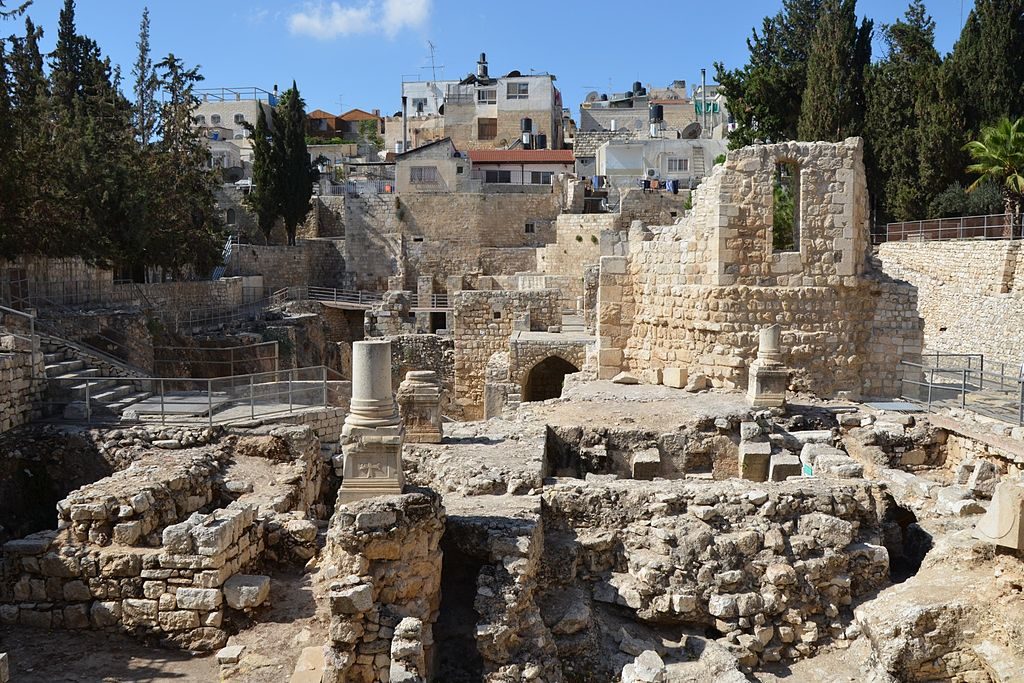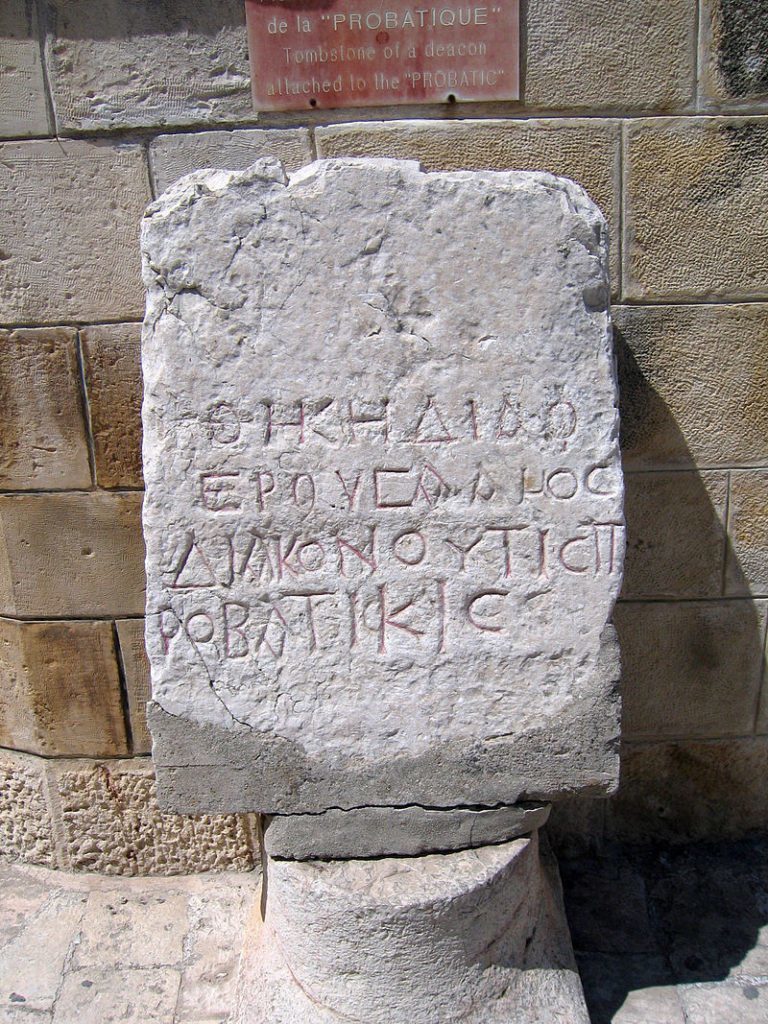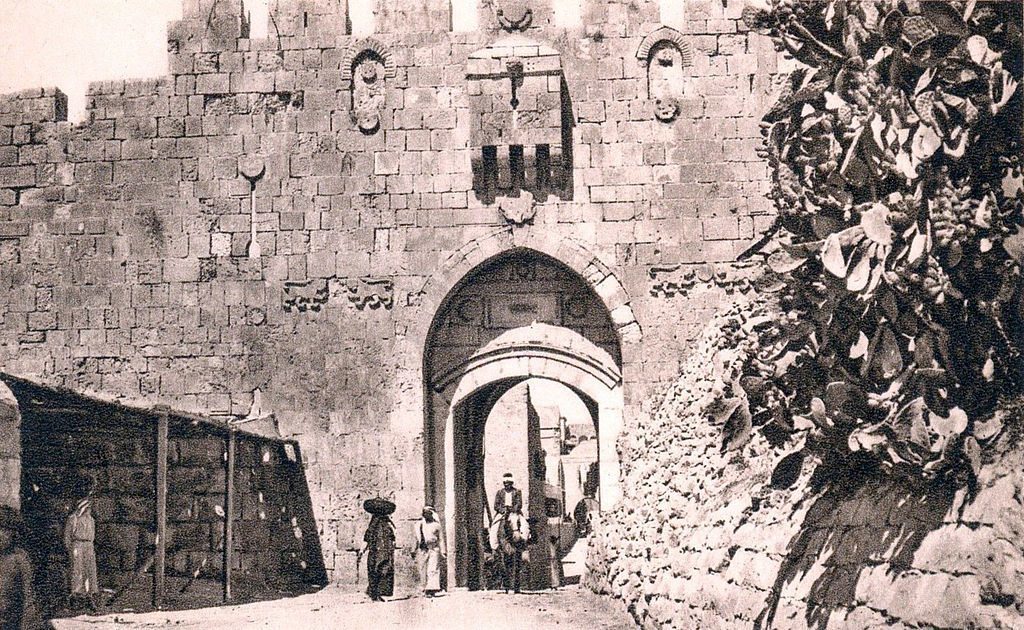The Gospel of John, contrary to the Synoptic Gospels, describes several visits by Jesus to Jerusalem prior to his final visit on the Passover of 30 CE. According to chapter 5 of John, Jesus came to Jerusalem for an unnamed Jewish festival and famously healed a paralyzed man on the Sabbath, attracting the criticism of the Jewish authorities.
The location of this miracle is precisely described by John, as follows:
Now there is in Jerusalem near the Sheep Gate a pool, which in Aramaic is called Bethzatha and which is surrounded by five covered colonnades.
Ἔστιν δὲ ἐν τοῖς Ἰεροσολύμοις ἐπὶ τῇ προβατικῇ κολυμβήθρα ἡἐπιλεγομένη Ἐβραϊστὶ Βηθζαθά, πέντε στοὰς ἔχουσα (John 5:2)
There are some interesting variants of the name of this pool in ancient NT manuscripts including: “Bethsaida,” “Belzetha” and “Bethesda.” All of these are due to copyists’ errors. Most likely, the authentic name of the pool was בית-חסדא (Beth Khisda or Beth Khasda), meaning the “house of mercy” in Aramaic. This could be because the pool was a well-known place of healing where God took mercy on invalids. John 5:2 says that the pool had “five stoas” sometimes translated as”five porticoes” (πέντε στοὰς). A portico is a covered walkway lined with columns which support the roof. Here is Prof. Michael Avi-Yonah’s suggestion of what the pool looked like, as seen in the famous Second Temple Jerusalem model at the Israel Museum. You can see that there are four sides to the pool, plus a fifth central portico that divides the pool into two. You can also see the Sheep’s Gate leading into the city on the upper left-hand corner of the image.
Much has been written about this five-colonnaded pool, which was excavated in the 19th century. It is located directly north of the Temple Mount. Contrary to most Christian pilgrimage sites in Jerusalem which have been covered over by modern churches, this unique site can be seen still exposed.
There is a great deal of scholarly and popular literature concerning this fascinating site. Much less discussed, however, is the other geographic detail provided in John 5:2, namely the gate located near this pool. In this blog-post I would like to take a closer look at the “Sheep Gate” mentioned in verse 5:2. First we should note that the gate is actually not called a “gate” at all by John. The original text of John literally says “next to the sheepish” (ἐπὶ τῇ προβατικῇ) – not “sheepish” is the metaphorical sense of “bashful” but in the literal sense of “something pertaining to the sheep.” This could be the “Sheep Market,” the “Sheep Pasture” or even the “Sheep Pool.” Let us, however, assume that the word “gate” is implied by John, since Nehemiah refers to the “Gate of the Sheep” (שער הצאן):
Eliashib the high priest and his fellow priests went to work and rebuilt the Sheep Gate. They dedicated it and set its doors in place, building as far as the Tower of the Hundred, which they dedicated, and as far as the Tower of Hananel (Nehemiah 3:1)
The real question here is: why was the northern gate of Jerusalem named “the gate of the sheep” (the full Greek name would have been: ἡ πύλη ἡ προβατική)? Likely because the main animal market where sacrificial sheep were bought and sold was located directly outside this gate in the Second Temple era. We can surmise that it was through this gate that sacrificial sheep were brought into the Temple after having been washed in the pool shown above. Before this pool became a place of healing, it was simply a water reservoir filled with collected rainwater used for cleaning purposes connected with the Temple. Perhaps the original name of the pool before it became a place of healing was the “Upper Pool” (הבריכה העליונה), as described in this passage:
The king of Assyria sent his supreme commander, his chief officer and his field commander with a large army, from Lachish to King Hezekiah at Jerusalem. They came up to Jerusalem and stopped at the aqueduct of the Upper Pool, on the road to the Washerman’s Field. (2 Kings 18:17, cf. Isaiah 7:13)
Perhaps, over time the name shifted from the “Upper Pool” to the “Sheep Pool” and the gate nearby was called the “Sheep Gate.” The Mishnah contains several references to a gate of the Temple called the “Tade Gate” (שער טדה) or the “Tadi Gate” (שער טדי). For example:
חמישה שערים היו להר הבית: שני שערי חולדה מן הדרום, משמשין כניסה ויציאה; קיפונוס מן המערב, משמש כניסה ויציאה; טדה מן הצפון, לא היה משמש כלום; שער מזרחי, עליו שושן הבירה צורה–שבו כוהן גדול השורף את הפרה, ופרה, וכל מסעדיה יוצאין להר המשחה. (m. Middot 1:3)
The word tadi does not have any known meaning. It could certainly be a proper noun, like the names of some of the other gates (Huldah, Kiponos, Shushan) mentioned in this passage. However, it has been suggested by scholars that this word should be emended to read tali (טלי), which means “lamb.” If so, this might well be the original Hebrew name of the gate mentioned in John 5:2.
Archaeology, as well, has preserved the name of the pool itself being connected with sheep. Pictured here is the tombstone of a 5th century Christian deacon named Amos which records the existence of a Byzantine church on this site which was called the Probatica (“of the sheep”).
Very near the site of the ancient Sheep’s Gate is the modern city gate which dates to the 16th century. Interestingly, it is known as the “Lions’ Gate.” Is there an intended connection between the animal names of these two gates (sheep and lion)? Is there a biblical subtext at work here? Maybe this is a physical illustration of this famous apocalyptic vision:
Then one of the elders said to me, “Do not weep! See, the Lion of the tribe of Judah, the Root of David, has triumphed. He is able to open the scroll and its seven seals.” Then I saw a Lamb, looking as if it had been slain, standing at the center of the throne, encircled by the four living creatures and the elders. The Lamb had seven horns and seven eyes, which are the seven spirits of God sent out into all the earth. (Revelation 5:5-6)
Or, perhaps we should think of this messianic vision of the ideal Davidic king:
The wolf will live with the lamb, the leopard will lie down with the goat, the calf and the lion and the yearling together; and a little child will lead them. (Isaiah 11:6)
Not likely. The name “Lions’ Gate” comes from the frieze of four lions (actually, panthers) seen on the wall above the gate, the heraldic symbol of the Mameluk sultan Baybars who controlled Jerusalem in the 13th century.
This is the northeast corner of the Old City, providing access to the Temple Mount from the Kidron Valley. In the Byzantine period this gate was referred to as the St Stephen’s gate, because tradition says that it was outside this gate that Stephen was martyred (Acts 7:58). Later, the gate which stood here was renamed Bab el-Ghor (the Jordan Valley gate) but this name is hardly used today.
The most important lesson to be learned from this fascinating site is that throughout Jerusalem’s long history, the topography of the landscape has always dictated where the city’s fortifications could and could not be built. For centuries, the builders of Jerusalem – Canaanite, Israelite, Jewish, Roman, Byzantine, Muslim, Crusader, Mameluk, Turkish – have reused the same locations for their walls and gates over and over. Because the eastern hill of the city dramatically gives way to the Kidron Valley at this point, it has always been the site of the northeastern gate. The names of these various gates are simply icing on this complex layer cake.











Thank you Jonathan Lipnick for sharing your knowledge of the Lion and the Sheep in reference to the gates. I believe that the lion represents Jesus and the sheep represent the people
Dr Jonathan, I am looking forward to taking your class and then hopefully someday coming to Israel to see these amazing sties in person. Your teaching was helpful not only in understanding the gate and pool, but to remind me that others have in habitated Jerusalem and made changes to suit their beliefs.
Thanks for the info, great to get the background behind the events of the past!
Thank you for an informative piece!
Quite an amazing insight to John 5:2.
Would House of Khisda/Khasda in Aramaic = Chesed in Hebrew?
Exactly.
This is very informative. The analogy of the various animals. lamb, lion shows contrast of strength and meekness. I am enjoying this blog. It is enlightening.
Very insightful as always!
This background information to the text quoted from John is very informative. However, I would find it helpful if you were to add arrows and names to the model and the actual site photo below it to make clear what the viewer is looking at. (Also,the gate I see in 2nd ‘model’ photo is on the upper left corner, and I do not see the one stated to be on the upper right.) Thank-you for a very interesting read.
Thanks for reading and for your comment. I have made the correction you suggested.
Very fascinating commentary.